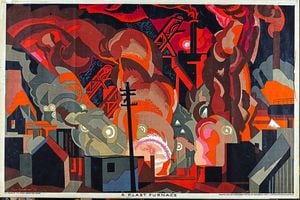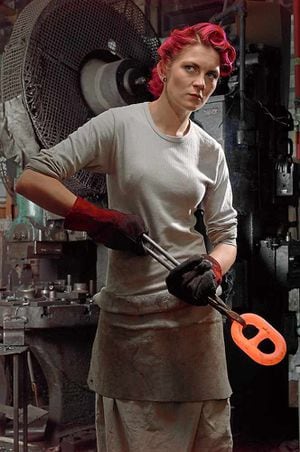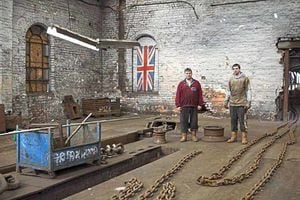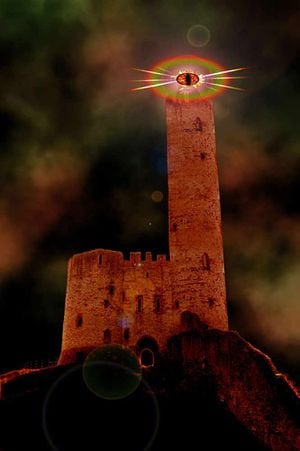Lord of the Rings link to Black Country past
Deep in Middle Earth, the world of JRR Tolkien's Lord of the Rings depicts the land of Mordor as a dark and oppressive place.

But a lesser known fact behind the beloved fantasy is that the realm of the dark lord Sauron was actually based upon the Black Country.
Now the origins of Mordor are to feature as part of an exhibition - one of a dozen taking place over the next few months to celebrate the culture and heritage of this industrial heartland.
The Making of Mordor will take place at Wolverhampton Art Gallery from September 20 to January 17.

It is just one of 27 exhibitions and 87 events at more than 25 venues taking place until January that encompass Black Country Echoes - a festival bringing together various arts bodies, theatres, libraries, churches, museums and more to celebrate the history, heritage and culture of Wolverhampton, Walsall, Sandwell and Dudley.
The Black Country may have given the world the likes of glassware, locks and leather but it also had a major impact on the world famous Lord of the Rings.
Tolkien grew up in Sarehole in Worcestershire, later part of Birmingham.
Like his famous Hobbits, this shire land was a very different place to the Black Country, not that far away.
In his writing Tolkien is anti-industrialist. The peace and tranquillity of The Shire is contrasted sharply with the intense manufacturing and destruction of the forests carried out by the wizard Saruman.

In The Return of the King, Saruman has taken over The Shire and started a process of 'modernisation' which is halted when the Hobbits return to lead a rebellion against him.
Organisers of the exhibition want to spark debates around the impact of industrialisation on the geography, people and economy of the Black Country.
Curator Carol Thompson said: "Tolkien loathed industrialisation.
"He saw it as an evil force, denaturing and dehumanising.
"Like many artists and authors of the late 19th and early 20th centuries, he associated industrial progress with the destruction of the countryside, the loss of traditional values and skills, and the corrosion of society.
"Tolkien's early childhood spent in the idyllic countryside that then skirted the south of Birmingham had a profound effect on his attitudes.
Just over the horizon was the heavily industrialised Black Country; its filthy air, ravaged landscape and fiery skies must have seemed like an ominous presence, ready to engulf his beloved home and all that he valued.

"Although Tolkien was careful not to link his early childhood life to locations or themes in the fantasy world of his novels, clear parallels can be drawn.
"'Mordor' translates as 'black lands' in Sindarin, the language of Tolkien's mythical lands and Tolkien's depictions of this poisoned region "resonate strongly with descriptions of the Black Country created by other writers of the time.
"The exhibition will also include a selection of personal items which belonged to JRR Tolkien, such as his hat and a pipe identical to his own, which he gave to his brother, as well as first editions of The Lord of the Rings and The Hobbit - one signed by the author. "
Using Tolkien's abhorrence for industry as a starting point, the exhibition explores the various artistic responses to the industrialisation of the Black Country and surrounding region, examining the struggle for dominance between nature and industry.
Through the eyes of artists working in the early and mid-1900s, it looks at the Black Country in its heyday (nicknamed 'The Workshop of the World') and explores some of Tolkien's key themes such as progress, the threat of technology, courage and loss.
The exhibition goes on to look from the perspective of contemporary artists working in the post-industrial era, when words such as 'progress' and 'loss' take on different connotations following the closure of many heavy industrial sites, such as Bilston's steelworks.
A dramatic installation, The Forked Forest Path, by internationally acclaimed artist Olafur Eliasson also features. This installation, constructed from more than 1,000 saplings sourced the Bilston Urban Village site, will form an indoor forest filling the entire gallery space.

A fork in the path through the forest will invite visitors to make a decision about their journey, similar to the decisions the Hobbits had to make on their journey in Lord of the Rings.
Other events on the links between the Black Country and Mordor include the Black Country Landscape in Literature talks at Wolverhampton's Arena Theatre on November 6 and the Road to Mordor, at Wolverhampton Art Gallery on October 17 and at Wolverhampton City Archives on November 12.
Author Bob Blackburn will explore the West Midlands roots of Tolkien's trilogy.
Family activities are planned for weekends and for half term as part of Black Country Echoes including late openings at Wolverhampton Art Gallery for a special spooky experience to coincide with an outdoor art installation by Tony Oursler, called The Influence Machine.
It will be set up in neighbouring St Peter's Gardens from 6pm to 7.30pm from October 29 to November 1.
The art gallery will be open until 8pm while the outdoor work will use videos of talking heads projected on to smoke, trees and buildings.
The aim is to make the ghosts of machines of such as telephones, television and the internet appear to have been released to roam at night.

The Light House is hosting special screenings of the Lord of the Rings Trilogy on Saturdays during the festival with the first screening on September 20 at 11am.
The Rectangular space at Wolverhampton Art Gallery will also feature responses by contemporary artists to the current and recent historical Black Country landscape and society and associated themes of nature, progress, loss and transition. Three photographers have been selected.
Richard Billingham was acclaimed for his candid depictions of his father and mother, made while he was living a council flat in Cradley Heath. But he has also made landscape photographs of places of personal significance around the Black Country.
Brian Griffin grew up amongst the factories of the Black Country. His early years living in a warren of terraced streets continually polluted by the smells and noise of industry remain indelibly printed on him and have shaped the person he is and his creative output. The photographs chosen for The Making of Mordor are autobiographical, reflecting Griffin's life in the 1950s and 1960s and his observations on industrial Britain after the Second World War.
Euripides Antintzoglou, a senior lecturer in photography at the University of Wolverhampton, has studied and worked in the Black Country since 1999. His Sunbeam project, featured in this exhibition, consists of gates of abandoned industrial sites in the Wolverhampton area.
Another exhibition taking place during the festival is Black Country Stories by Martin Parr at the New Art Gallery in Walsall.
It will run from October 4 to January 11.
Mr Parr is currently working with Sandwell-based Multistory to create a photographic portrait and archive of life in the Black Country using photography and film.
He has been working across the Black Country since 2010 and has visited factories, foundries, working men's clubs, Royal Wedding street parties, horticultural shows, dog training classes and more. The images capture and celebrate the unique mix of communities living in the area as well as existing, traditional Black Country life.
The exhibition will feature 122 photographs as well as 400 archive images, oral histories and the four documentary films made by Mr Parr. An early evening talk by the photographer will take place at the Gallery on November 11 at 6.30 pm.
Ten smaller exhibitions will feature as part of the festival too.
Echoes of Glass will run from September 10 to October 3 at Plowden and Thompson and Tudor Crystal, with tours of the factory and glass blowing.
Telephone in the Hall at Wednesbury Museum and Art Gallery opens in October and features a 1960s living room and kitchenette/
From September 20 to January 10 there will be an exhibition of the post war leather trade at Walsall Leather Museum.
Enchantment at Red House Glass Cone in Stourbridge runs from November 8 to January and features work by studio artists while Echoes of the Past and Future runs at Dudley Museum and Art Gallery from September 27, showing work by contemporary artists of the industrial landscape of the Black Country.
Austerity to Prosperity at Walsall Museum takes place from September 3 and shows life in the late 1940s to 1950s for Black Country industries. It looks at how factories were transformed from munitions work and produced the most innovative and inspiring homewares and fashion products.
Simon Redgrave's Hired Hands shows portraits from the workplace at Wolverhampton Art Galley in September. This pop-up touring exhibition celebrates the working lives of Black Country people.
Ed Cartwright's Made In Metal shows creatures made of cutlery at Scary Canary in Stourbridge while other 'Black Countries' across Europe are the subject of Stanza's Parallel Realities at Wolverhampton Art Gallery from September to December.
Bilston Craft Gallery hosts Craft and Conflict - looking at work on war and remembrance and featuring items made by Black Country companies such as helmets and grenades. It runs from September 13 to November 22.
More details on all the various events for Black Country Echoes can be found at http://www.blackcountryechoes.org.uk/
Quotes from JRR Tolkien's The Lord of the Rings: The Two Towers – Book 4, Chapter 2: 'The Passage of the Marshes' have prompted parallels to be drawn with the Black Country.
A selection of these to be used as wall text – displayed alongside the artworks at Wolverhampton Art Gallery.
'.. they frowned across a dismal waste… The land ahead rose in long shallow slopes, barren and pitiless, towards the desert that lay at Sauron's gate.'
'… For two more nights they struggled on through the weary pathless land. The air, as it seemed to them, grew harsh, and filled with a bitter reek that caught their breath and parched their mouths.'
'… Before them dark in the dawn the great mountains reached up to roofs of smoke and cloud.'
'… here nothing lived, not even the leprous growth that feed on rottenness. The gasping pools were choked with ash and crawling muds, sickly white and grey, as if the mountains had vomited the filth of their entrails upon the lands about. High mounds of crushed and powdered rock, great cones of earth fire-blasted and poison-stained, stood like an obscene graveyard in endless rows, slowly revealed in the reluctant light.'
'They had come to the desolation that lay before Mordor: the lasting monument to the dark labour of its slaves that should endure when all their purposes were made void; a land defiled, diseased beyond all healing – unless the Great Sea should enter in and wash it with oblivion.'
'The gasping pits and poisonous mounds grew hideously clear. The sun was up, walking among clouds and long flags of smoke, but even the sunlight was defiled.'
'For a while they sat without speaking under the shadow of a mound of slag; but foul fumes leaked out of it, catching their throats and choking them.'





